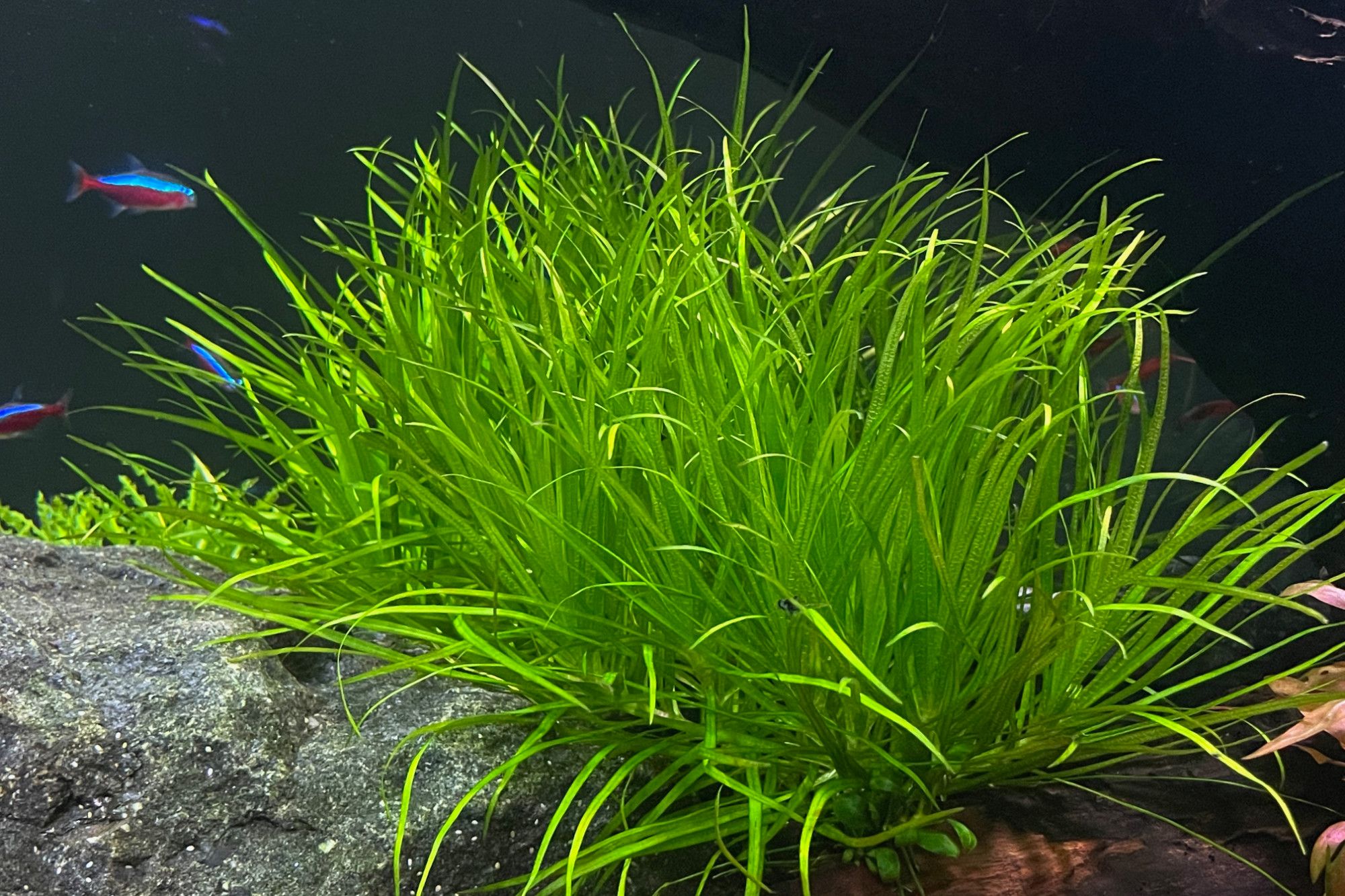General Information
Dwarf Asian Grass (Blyxa Japonica) is a submersed stem plant that originates in Japan and usually grows in nutrient-rich shallow waters, swamps and slow flowing rivers and streams. In Japan it is also often seen in rice fields.
It is a very popular aquarium plant due to its lush green color, grass-like appearance and bushy growth. Dwarf Asian Grass is suitable for all tanks and can be placed in the foreground and middleground. Its leaves are linear, long and soft with a dark green to golden / red color. The Blyxa Japonica has branched shoots. The more nutrition (light, CO² and fertilizer) it receives, the more golden reddish the leaves will turn and in general the plant will grow more dense. Otherwise the leaves will have a lush green color, be more delicate and grow higher.
It can grow from 10 to 20 cm tall. Since it has a moderate growth rate, it should be combined with either a massive quantity of other moderate-growing plants or fast-growing plants in order to prevent algae.
The following sections give an in-depth overview on how to plant, grow and propagate the plant in your tank successfully.
How to plant Dwarf Asian Grass
Dwarf Asian Grass is a stem plant, which means it needs to be planted in soil. It is best placed deep into soil with the help of tweezers while making sure that at least 2-3 cm of the plant remain visible.
Where to place Dwarf Asian Grass
Due to its medium size of maximum 20 cm, Dwarf Asian Grass is best suited as a foreground and middleground plant and can be used in all tanks from nano size upwards.
The step-by-step process to plant Dwarf Asian Grass
- Before beginning, make sure the aquarium is not filled with water yet, but the soil is wet.
- Most likely the Dwarf Asian Grass will arrive in an in-vitro container or cup. Carefully remove the plant from the container and wash the plant under fresh and unchlorinated water until all of the nutrient paste or gel is removed.
- Carefully break up the plant mass into small batches using your hands.
- Use tweezers to pick up each small batch by the roots at an angle of approximately 45°. Be careful not to squeeze the plant too tight, otherwise you might damage the roots.
- Now push the plant into the soil using the tweezers in a 45° angle until only the tip of the plant is coming out of the soil. It's better to plant the plant a little too deeply than too shallowly. Otherwise, it might float to the top before roots can attach properly.
- After pushing the plant into the soil, don't just pull the tweezers out. Instead, pull the tweezers out in a slow and wiggling motion in order not to pull the plant with you and disturb the soil to cover the plant.
How to grow Dwarf Asian Grass fast
The overall growth-rate of Dwarf Asian Grass is moderate. There are, however, some things you can do to speed up the process further:
- Adding CO² to your tank: Moderate CO² injection of about 24 to 40 mg/l is advised for optimum health and growth of Blyxa Japonica.
- Add nutrients to your tank: Blyxa Japonica needs regular fertilization with potassium, phosphate, nitrate and micronutrients to grow.
- Choose the right spot: The plant needs medium to high light for a sufficient amount of time in order to thrive in your tank. Make sure to plant it in a spot that allows for its bushy and large growth, so that it doesn't have to compete with other plants for nutrients in the soil.
How to propagate Dwarf Asian Grass
Cut the plant stem minimum 3 cm from the top. Plant the stem according the steps mentioned in the "How to plant"-section.
Common problems with Dwarf Asian Grass
- Yellow Leaves: In case the leaves on Dwarf Asian Grass turn yellow, this is a sign for lack of nutrients in the water. We suggest to check the water parameters in order to determine which fertilizer to add.
- Melting Leaves: In case the leaves on Dwarf Asian Grass seem to rot or melt, this might also be a sign for lack of nutrients in the water or soil. Other reasons could be too much or too little light. In these cases, it's best to measure your tank parameters and compare them to the data in the "plant characteristic" table in the top right of this page.
- Sudden deterioration: Sudden changes of water parameters (e.g. hardness or pH level) can cause Blyxa Japonica to deteriorate and melt. It's best to plant it in an established tank or one that will have relatively stable parameters from the start (e.g. bigger tanks with regular water changes)
